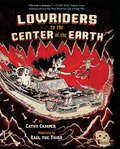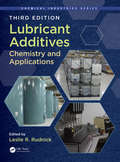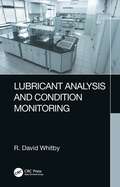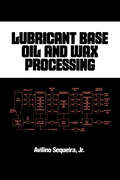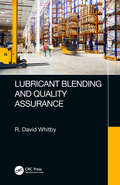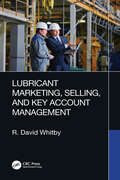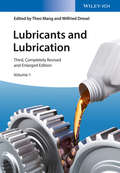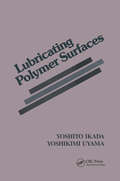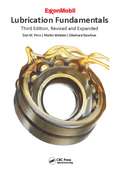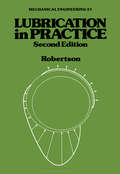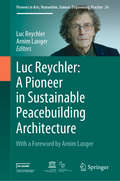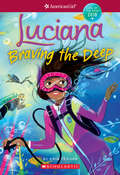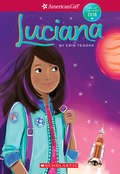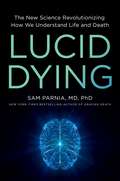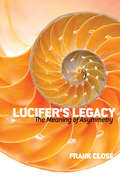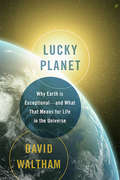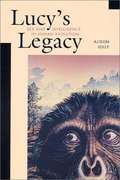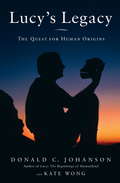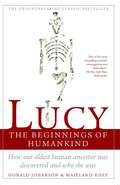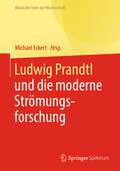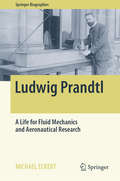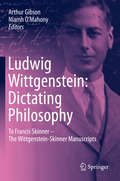- Table View
- List View
Lowland Grassland and Heathland Habitats (Habitat Guides)
by Elizabeth PriceGrasslands are everywhere: agricultural land, playing fields and road verges; but while species-poor, intensively managed grasslands are widespread, colourful semi-natural grasslands and heathlands, buzzing with life, are scarce. These semi-natural habitats are ancient, cultural landscapes, which are of considerable, if not international importance for biodiversity. However, despite targets for the conservation and restoration of these valuable grasslands and heathlands, these habitats continue to decline before our eyes. Lowland Grassland and Heathland Habitats contrasts the uniformity of intensively managed grassland with the diversity of traditionally managed grasslands and heathlands. It examines topics of concern to the ecologist or habitat manager such as causes of the loss and deterioration of these habitats, including inappropriate management, eutrophication and climate change. It then evaluates opportunities for positive change, such as conservation, restoration and creation. A series of case-studies illustrates the pressures on some lowland grassland and heathland habitat types and looks at ways to enhance them for biodiversity. This habitat guide features illustrated species boxes of typical plants and animals, as well as a full species list, a series of projects on the ecology of grassland and heathland species, a colour plate section, up-to-date references and information, and a full glossary. It will provide students and environmentalists with a deeper understanding of the nature and importance of lowland grasslands and heathlands.
Lowly Origin: Where, When, and Why Our Ancestors First Stood Up
by Jonathan KingdonOur ability to walk on two legs is not only a characteristic human trait but one of the things that made us human in the first place. Once our ancestors could walk on two legs, they began to do many of the things that apes cannot do: cross wide open spaces, manipulate complex tools, communicate with new signal systems, and light fires. Titled after the last two words of Darwin's Descent of Man and written by a leading scholar of human evolution, Lowly Origin is the first book to explain the sources and consequences of bipedalism to a broad audience. Along the way, it accounts for recent fossil discoveries that show us a still incomplete but much bushier family tree than most of us learned about in school. Jonathan Kingdon uses the very latest findings from ecology, biogeography, and paleontology to build a new and up-to-date account of how four-legged apes became two-legged hominins. He describes what it took to get up onto two legs as well as the protracted consequences of that step--some of which led straight to modern humans and others to very different bipeds. This allows him to make sense of recently unearthed evidence suggesting that no fewer than twenty species of humans and hominins have lived and become extinct. Following the evolution of two-legged creatures from our earliest lowly forebears to the present, Kingdon concludes with future options for the last surviving biped. A major new narrative of human evolution, Lowly Origin is the best available account of what it meant--and what it means--to walk on two feet.
Lowriders to the Center of the Earth (Lowriders #2)
by Cathy Camper Raul The ThirdThe lovable trio from the acclaimed Lowriders in Space are back! Lupe Impala, Elirio Malaria, and El Chavo Octopus are living their dream at last. They're the proud owners of their very own garage. But when their beloved cat Genie goes missing, they need to do everything they can to find him. Little do they know the trail will lead them to the realm of Mictlantecuhtli, the Aztec god of the Underworld, who is keeping Genie prisoner! With cool Spanish phrases on every page, a glossary of terms, and an action-packed plot that sneaks in science as well as Aztec lore, Lowriders to the Center of the Earth is a linguistic and visual delight. ¡Que suave!
Lubricant Additives: Chemistry and Applications, Third Edition (Chemical Industries #Vol. 90)
by Leslie R. RudnickThis indispensable book describes lubricant additives, their synthesis, chemistry, and mode of action. All important areas of application are covered, detailing which lubricants are needed for a particular application. Laboratory and field performance data for each application is provided and the design of cost-effective, environmentally friendly technologies is fully explored. This edition includes new chapters on chlorohydrocarbons, foaming chemistry and physics, antifoams for nonaqueous lubricants, hydrogenated styrene–diene viscosity modifiers, alkylated aromatics, and the impact of REACh and GHS on the lubricant industry.
Lubricant Analysis and Condition Monitoring
by R. David WhitbyAlmost all mechanical devices used in every industry require lubrication. Lubricant Analysis and Condition Monitoring explains the benefits of identifying, planning, implementing and using lubricant and machine condition monitoring programmes to extend the lifetimes of both lubricants and machines, to achieve maximum productivity and profitability while reducing impacts on waste and the environment. This book: Offers a comprehensive overview of all types of tests used in lubricant condition monitoring programmes Discusses monitoring the condition of all types of components, machines, equipment and systems used in all industries Considers new and emerging machines, equipment and systems, including electric and hybrid vehicles Suggests which tests to use for each type of machine, equipment or system and, just as importantly, which tests not to use Provides practical examples of how to set up, run and manage condition monitoring programmes and how to achieve significant cost savings through planned and predictive maintenance schedules Gathering vital information that users of lubricants need in one place, this book is of practical use to mechanical, maintenance, manufacturing and marine engineers as well as metallurgists, chemists and maintenance technicians.
Lubricant Base Oil and Wax Processing (Chemical Industries)
by Avilino SequeiraProvides state-of-the-art information on all processes currently used to manufacture lubricant base oils and waxes-offering practical, timesaving solutions for specific on-the-job problems. Furnishes helpful lists of conversion factors, construction cost data, and process licensors, as well as a glossary of essential petroleum processing terms.
Lubricant Blending and Quality Assurance
by R. David WhitbyMany people, including those involved in the manufacturing, marketing and selling of lubricants, believe that blending lubricants is simply a matter of putting one or more base oils and several additives into a tank of some kind and stirring them around to mix them. Blending lubricants that meet customers’ demands requires much more than this. The correct ingredients of the right quality need to be used in precisely controlled quantities. The ingredients need to be tested prior to blending and the finished products need to be tested following blending. The ingredients need to be stored and mixed under carefully controlled conditions. The finished lubricants need to be stored and packaged carefully and then delivered to customers correctly. <P><P>This book discusses all of these issues, describes the different types of equipment used to blend lubricants, provides guidance on how best to use this equipment, and offers tips and techniques to help to avoid problems. It focuses on liquid lubricants. Greases are not discussed, as their manufacture involves very different manufacturing procedures compared with those concerned with liquid lubricants. <P><P>The book starts with descriptions and discussion of the properties and characteristics of the main types of mineral and synthetic base oils, as well as the properties and characteristics of the main types of additives that are used in lubricant formulations. Criteria and methodologies used to design both new and upgraded blending plants are covered next. The types and operation of the equipment used in lubricant blending plants are described and discussed, together with a chapter on how to avoid problems before, during, and after blending. Testing and analysis of base oils, additives, and blended lubricants are covered in two separate chapters. Procedures for quality control and quality management in lubricant blending plants are also discussed in two separate chapters. Types of packages for lubricants are reviewed, together with methods for filling packages and methods for transporting lubricants in bulk. The storage of lubricants and supply chain management is also covered in depth.
Lubricant Marketing, Selling, and Key Account Management
by R. David WhitbyThe global lubricants market exceeds $110 billion, with strong future-estimated annual growth projections. While much has been written about the technical aspects of lubricant development, Lubricant Marketing, Selling, and Key Account Management fills a need for a comprehensive guide on the important commercial aspects of the business, offering unique and valuable insights from a veteran of the industry. It answers questions and offers insights on how to effectively market and sell all types of lubricants, including automotive, industrial, mining, marine, agricultural and aerospace, among others. Covers how and why people and companies buy lubricants. Instructs readers how to research and analyze markets and use the results to plan marketing and sales campaigns and activities. Details how to identify specific target market segments and sell to key lubricant accounts. Discusses how to forecast future demand for lubricants in all types of global markets. This practical book is written for technical and non-technical readers involved in the sale and management of lubricant products and offers hands-on guidance for how to successfully navigate and grow your profitability in this vitally important product sector.
Lubricants and Lubrication, 2 Volume Set
by Mang Wilfried DreselPraise for the previous edition: “Contains something for everyone involved in lubricant technology” — Chemistry & Industry This completely revised third edition incorporates the latest data available and reflects the knowledge of one of the largest companies active in the business. The authors take into account the interdisciplinary character of the field, considering aspects of engineering, materials science, chemistry, health and safety. The result is a volume providing chemists and engineers with a clear interdisciplinary introduction and guide to all major lubricant applications, focusing not only on the various products but also on specific application engineering criteria. A classic reference work, completely revised and updated (approximately 35% new material) focusing on sustainability and the latest developments, technologies and processes of this multi billion dollar business Provides chemists and engineers with a clear interdisciplinary introduction and guide to all major lubricant applications, looking not only at the various products but also at specific application engineering criteria All chapters are updated in terms of environmental and operational safety. New guidelines, such as REACH, recycling alternatives and biodegradable base oils are introduced Discusses the integration of micro- and nano-tribology and lubrication systems Reflects the knowledge of Fuchs Petrolub SE, one of the largest companies active in the lubrication business 2 Volumes wileyonlinelibrary.com/ref/lubricants
Lubricating Polymer Surfaces
by Yoshikimi UyamaA lubricating polymer surface is important, especially in biomedical technologies. Low-friction surfaces enable easy insertion and removal of devices from patients. Earlier approaches were mostly simple applications involving lubricants such as lidocaine jelly, silicone oil, or non-permanent coating with low-friction materials such as polyethylene or fluoroplastics. However, these substances cannot maintain a high degree of slipperiness for the required duration of time. This book describes the principle of lubrication, outlines a variety of methods for attaining a lubricous surface, and describes the characteristics and properties of such lubricous surfaces.
Lubrication Fundamentals, Revised and Expanded
by Don M. Pirro Martin Webster Ekkehard DaschnerCareful selection of the right lubricant(s) is required to keep a machine running smoothly. Lubrication Fundamentals, Third Edition, Revised and Expanded describes the need and design for the many specialized oils and greases used to lubricate machine elements and builds on the tribology and lubrication basics discussed in previous editions. <P><P>Utilizing knowledge from leading experts in the field, the third edition covers new lubrication requirements, crude oil composition and selection, base stock manufacture, lubricant formulation and evaluation, machinery and lubrication fundamentals, and environmental stewardship. The book combines lubrication theory with practical knowledge, and provides many useful illustrations to highlight key industrial, commercial, marine, aviation, and automotive lubricant applications and concepts. All previous edition chapters have been updated to include new technologies, applications, and specifications that have been introduced in the past 15 years. <P><P>What’s New in the Third Edition: <Li>Adds three new chapters on the growing renewable energy application of wind turbines, the impact of lubricants on energy efficiency, and best practice guidelines on establishing an in-service lubricant analysis program <Li>Updates API, SAE, and ACEA engine oil specifications, descriptions of new engine oil tests, impact of engine and fuel technology trends on engine oil <Li>Includes the latest environmental lubricant tests, definitions, and labelling programs <Li>Compiles expert information from ExxonMobil publications and the foremost international equipment builders and industry associations <Li>Covers key influences impacting lubricant formulations and technology <Li>Offers data on global energy demand and interesting statistics such as the worldwide population of nuclear reactors, wind turbines, and output of hydraulic turbines <Li>Presents new sections on the history of synthetic lubricants and hazardous chemical labeling for lubricants <P><P>Whether used as a training guide for industry novices, a textbook for students to understand lubrication principles, or a technical reference for experienced lubrication and tribology professionals, Lubrication Fundamentals, Third Edition, Revised and Expanded is a "must read" for maintenance professionals, lubricant formulators and marketers, chemists, and lubrication, surface, chemical, mechanical, and automotive engineers.
Lubrication in Practice
by W. L. RobertsonThis book will appeal to a broad range of engineers and managers in all sectors of manufacturing engineering, power generation and transport. Drawing on their specialist experience and knowledge, the many contributors show how the careful application of correct lubrication can lead to improved productivity, longer plant and equipment life and higher profits. Throughout the emphasis is on showing what lubricants can do, and how they can best be used. After introductory chapters that summarise the basic theory and the general types and properties of lubricants, there follow eleven chapters that cover such specific applications as diesel and petrol engines, hydraulics, compressors, machine tools and cutting oils. The last two chapters discuss the storage and handling of lubricants, and lubrication planning. The majority of the authors and editors, have worked for Esso Petroleum Company Limited and have a unique range of experience in this area. Many of the authors have contrbuted to advances in techniques for imrproved lubrication in their specialist areas.
Luc Reychler: A Pioneer in Sustainable Peacebuilding Architecture (Pioneers in Arts, Humanities, Science, Engineering, Practice #24)
by Arnim Langer Luc ReychlerThis book provides a unique personal perspective on the field of peace research. It not only highlights Luc Reychler’s significant contributions to the theory and praxis of sustainable peacebuilding, but also offers important reflections on the evolution of peace research as an independent discipline. The central concept of this book – and of Reychler’s academic career, for that matter – is sustainable peacebuilding architecture. Reychler introduced this concept in order to draw attention to the architectural principles and considerations that have to be addressed in sustainable peacebuilding processes. Reychler’s work on sustainable peacebuilding architecture has been groundbreaking and has not lost any of its relevance in the twenty-first century. By bringing together Reychler’s seminal texts on sustainable peacebuilding architecture, the current book aims to offer academics, students and policymakers an essential guide to understanding, studying and applying this crucial concept.• Provides a unique personal view of the development of peace research• Lists the necessary building blocks for sustainable peacebuilding• Offers tools for monitoring and evaluating interventions• Discusses the scientific nature and often provocative findings of peace research • Discusses ten lessons learned and the future (Peace Research III)
Luchadores: El testimonio de padres de niños con trastornos neurológicos
by Fundación Luchadores AvaPrólogo de Irene Villa. «Tienen en sus manos un libro sobrecogedor que inquieta pero nos llena de amor y esperanza, es un auténtico alegato de vida, de encontrar la forma y la actitud necesarias para luchar sin descanso y de no rendirse jamás». Irene Villa. Esta es una obra, ante todo, alegre, optimista, motivadora, inspiradora un canto a la vida. Un libro que te hará llorar y reír, y que sacará lo mejor de ti. Te hará ver la vida de otra manera y afrontarla con mayor fuerza y alegría. A través de él vivirás más de once vidas, las vidas de once padres y un abuelo que te contarán cómo afrontan la enfermedad de su hijo. No los oirás quejarse o maldecir su suerte. Te hablarán del amor que sienten por sus hijos, de cómo han cambiado sus vidas, sus prioridades y su forma de pensar. Te enseñarán a afrontar los pequeños o grandes problemas diarios mediante sus propias vivencias y, sobre todo, te irás con una gran lección: que el amor que siente un padre por su hijo todo lo puede. Conocerás la lucha diaria de estos niños que no tienen voz, queson los grandes olvidados de una sociedad atareada que ha perdido sus valores. Niños que con sus grandes sonrisas y sus ganas de vivir son capaces de cambiar a cualquiera que se cruce en su camino y se detenga a conocerlos. ¡Déjate cambiar por ellos!
Luciana: Braving The Deep (girl Of The Year 2018, Bk. 2) (American Girl: Girl of the Year 2018 #2)
by Lucy Truman Erin TeaganIn her second novel, Luciana is off to youth astronaut training camp! She hopes to be chosen to dive to an underwater habitat where real astronauts train for life in space. But when Luci accuses her diving partner of sabotage, no one believes her and her chances of making the diving team sink fast. Things hit rock bottom when Luci has an underwater crisis. Suddenly, making the dive team isn’t her biggest worry. She’ll have to conquer her fears if she ever wants to make it to Mars. If she can’t, will she have to kiss her dreams of becoming an astronaut good-bye?
Luciana: Out Of This World (American Girl: Girl of the Year 2018 #1)
by Lucy Truman Erin TeaganGet to know American Girl's 2018 Girl of the Year, Luciana, in this first book in her series! Luciana is over the moon—she's going to Space Camp! But when she's picked to lead her team in a robot challenge, instead of rocketing her crew to success she steers them straight into trouble. After that, her teammates don't trust her. In fact, Luci's pretty sure they don't even like her. It's great to be good at science—but Luci learns that it's not enough. If she's ever going to make it to Mars, she's got to be someone her crew can depend on, no matter what.
Lucid Dying: The New Science Revolutionizing How We Understand Life and Death
by Sam ParniaFrom internationally renowned expert in resuscitation and New York Times bestselling author Sam Parnia, MD, PhD, comes a groundbreaking look at what happens to us when we die, based on the largest-ever research study run on recalled experiences of death. Today, for the first time in history, the scientific exploration of death and what happens when we die is real, active and ongoing. Contrary to popular perceptions, this subject is no longer the remit of philosophy, religion, or personal opinion. Truly remarkable scientific discoveries that will fundamentally affect everyone&’s lives now and in the future are taking place, yet very few people are aware of them. Most people—including scientists and doctors—maintain strong beliefs about death and its experience. Those beliefs are rooted in traditional, and often cultural, notions of death. But what if all that we have come to believe about death is fundamentally wrong? What if the paradigm we have been operating within no longer exists? What if death is not the end we thought?Lucid Dying is the first book to share that science. Presenting data derived from multiple groundbreaking studies, Dr. Parnia shows that the entity we refer to as consciousness—our Self—does not seem to become annihilated when we die. In fact, during death, our consciousness vastly expands and leads to a vivid experience that follows a very specific narrative arc. These studies support that there really is a universal experience of death that is meaningful, transcendent, positive, and transformative—not hallucinatory, delusional, or illusory as previously imagined. In his latest book, Dr. Parnia weaves empirical research with gripping stories to show us the truth of how death is not the end we all thought and how anyone can harness the newfound wisdom to lead deeper, more intentional lives.
Lucifer's Legacy: The Meaning of Asymmetry
by Frank Close"This is Frank Close's masterpiece -- his best book, and one of the very best introductions to physics for the layperson. Close is a master expositor." -- The (London) Sunday Times"Close's writing is beguiling, mingling personal and historical anecdote with carefully measured doses of exposition in such a way as to guide the reader painlessly into rather deep intellectual waters." -- Nature "Life, intrinsically related to asymmetries, is the theme of this book, and Close offers us an absorbing and scientifically correct account of symmetry and its deep implications." -- CERN CourierThis thought-provoking work by a physicist and popular science writer explores the origins of asymmetry from the molecular level to that of the universe at large. Frank Close takes the readers on a tour of asymmetry that ranges from the development of human embryos to the mysterious Higgs boson, or "God particle," and ongoing research at Switzerland's CERN laboratory.
Lucky Planet: Why Earth is Exceptional-and What That Means for Life in the Universe
by David WalthamWhy Earth’s life-friendly climate makes it exceptional--and what that means for the likelihood of finding intelligent extraterrestrial life We have long fantasized about finding life on planets other than our own. Yet even as we become aware of the vast expanses beyond our solar system, it remains clear that Earth is exceptional. The question is: why? In Lucky Planet, astrobiologist David Waltham argues that Earth’s climate stability is what makes it uniquely able to support life, and it is nothing short of luck that made such conditions possible. The four billion year-stretch of good weather that our planet has experienced is statistically so unlikely that chances are slim that we will ever encounter intelligent extraterrestrial others. Citing the factors that typically control a planet’s average temperature--including the size of its moon, as well as the rate of the Universe’s expansion--Waltham challenges the prevailing scientific consensus that Earth-like planets have natural stabilizing mechanisms that allow life to flourish. A lively exploration of the stars above and the ground beneath our feet, Lucky Planet seamlessly weaves the story of Earth and the worlds orbiting other stars to give us a new perspective of the surprising role chance plays in our place in the universe.
Lucy's Legacy: Sex And Intelligence In Human Evolution
by Alison Jolly<p>Alison Jolly believes that biologists have an important story to tell about being human--not the all-too-familiar tale of selfishness, competition, and biology as destiny but rather one of cooperation and interdependence, from the first merging of molecules to the rise of a species inextricably linked by language, culture, and group living. This is the story that unfolds in Lucy's Legacy, the saga of human evolution as told by a world-renowned primatologist who works among the female-dominant ringtailed lemurs of Madagascar. <p>We cannot be certain that Lucy was female--the bones themselves do not tell us. However, we do know, as Jolly points out in this erudite, funny, and informative book, that the females who came after Lucy--more adept than their males in verbal facility, sharing food, forging links between generations, migrating among places and groups, and devising creative mating strategies--played as crucial a role in the human evolutionary process as "man" ever did. In a book that takes us from the first cell to global society, Jolly shows us that to learn where we came from and where we go next, we need to understand how sex and intelligence, cooperation and love, emerged from the harsh Darwinian struggle in the past, and how these natural powers may continue to evolve in the future.</p>
Lucy's Legacy: The Quest for Human Origins
by Kate Wong Dr Donald Johanson"Lucy is a 3.2-million-year-old skeleton who has become the spokeswoman for human evolution. She is perhaps the best known and most studied fossil hominid of the twentieth century, the benchmark by which other discoveries of human ancestors are judged."-From Lucy's LegacyIn his New York Times bestseller, Lucy: The Beginnings of Humankind, renowned paleoanthropologist Donald Johanson told the incredible story of his discovery of a partial female skeleton that revolutionized the study of human origins. Lucy literally changed our understanding of our world and who we come from. Since that dramatic find in 1974, there has been heated debate and-most important-more groundbreaking discoveries that have further transformed our understanding of when and how humans evolved. In Lucy's Legacy, Johanson takes readers on a fascinating tour of the last three decades of study-the most exciting period of paleoanthropologic investigation thus far. In that time, Johanson and his colleagues have uncovered a total of 363 specimens of Australopithecus afarensis (Lucy's species, a transitional creature between apes and humans), spanning 400,000 years. As a result, we now have a unique fossil record of one branch of our family tree-that family being humanity-a tree that is believed to date back a staggering 7 million years.Focusing on dramatic new fossil finds and breakthrough advances in DNA research, Johanson provides the latest answers that post-Lucy paleoanthropologists are finding to questions such as: How did Homo sapiens evolve? When and where did our species originate? What separates hominids from the apes? What was the nature of Neandertal and modern human encounters? What mysteries about human evolution remain to be solved?Donald Johanson is a passionate guide on an extraordinary journey from the ancient landscape of Hadar, Ethiopia-where Lucy was unearthed and where many other exciting fossil discoveries have since been made-to a seaside cave in South Africa that once sheltered early members of our own species, and many other significant sites. Thirty-five years after Lucy, Johanson continues to enthusiastically probe the origins of our species and what it means to be human.From the Hardcover edition.
Lucy: The Beginnings of Humankind
by Maitland A. Edey Donald C. JohansenThe dramatic discovery of our oldest human ancestor and the controversial change it makes in our view of human origins<P><P> Winner of the National Book Award
Ludwig Prandtl und die moderne Strömungsforschung: Ausgewählte Texte zum Grenzschichtkonzept und zur Turbulenztheorie (Klassische Texte der Wissenschaft)
by Michael Eckert((vorläufig))In diesem Band werden die wichtigsten Artikel Prandtls zu Turbulenzen und zur Grenzschichttheorie vorgestellt, kommentiert und in einen historischen sowie sozio-kulturellen Hintergrund eingeordnet.
Ludwig Prandtl: Ein Unverstellter Blick Auf Sein Leben
by Michael EckertThis is a comprehensive biography of Ludwig Prandtl (1875-1953), the father of modern aerodynamics. His name is associated most famously with the boundary layer concept, but also with several other topics in 20th century fluid mechanics, particularly turbulence (Prandtl's mixing length). Among his disciples are pioneers of modern fluid mechanics such as Heinrich Blasius, Theodore von Kármán and Walter Tollmien. Furthermore, Prandtl founded the Aerodynamische Versuchsanstalt (AVA) and the Kaiser-Wilhelm-Institut für Strömungsforschung in Göttingen, both of them seeds for the growth of fluid mechanics in Germany. <P><P> Yet Prandtl was also a representative of aeronautical research - from Imperial Germany via the Weimar Republic to the "Third Reich". Although not a party member, he assumed the role of a goodwill ambassador for Nazi Germany. This objective treatment of his career will be of interest to all scientists and historians wanting to learn more about Prandtl's influence and the early development of fluid- and aerodynamics.
Ludwig Wittgenstein: To Francis Skinner – The Wittgenstein-Skinner Manuscripts
by Ludwig Wittgenstein Francis SkinnerIn this volume we witness Wittgenstein in the act of composing and experimenting with his new visions in philosophy. The book includes key explanations of the origin and background of these previously unknown manuscripts. It investigates how Wittgenstein’s philosophical thought-processes are revealed in his dictation to, as well as his editing and revision with Francis Skinner, in the latter’s role of amanuensis. The book displays a considerable wealth and variety of Wittgenstein’s fundamental experiments in philosophy across a wide array of subjects that include the mind, pure and applied mathematics, metaphysics, the identities of ordinary and creative language, as well as intractable problems in logic and life. He also periodically engages with the work of Newton, Fermat, Russell and others. The book shows Wittgenstein strongly battling against the limits of understanding and the bewitchment of institutional and linguistic customs. The reader is drawn in by Wittgenstein as he urges us to join him in his struggles to equip us with skills, so that we can embark on devising new pathways beyond confusion. This collection of manuscripts was posted off by Wittgenstein to be considered for publication during World War 2, in October 1941. None of it was published and it remained hidden for over two generations. Upon its rediscovery, Professor Gibson was invited to research, prepare and edit the Archive to appear as this book, encouraged by Trinity College Cambridge and The Mathematical Association. Niamh O’Mahony joined him in co-editing and bringing this book to publication.


